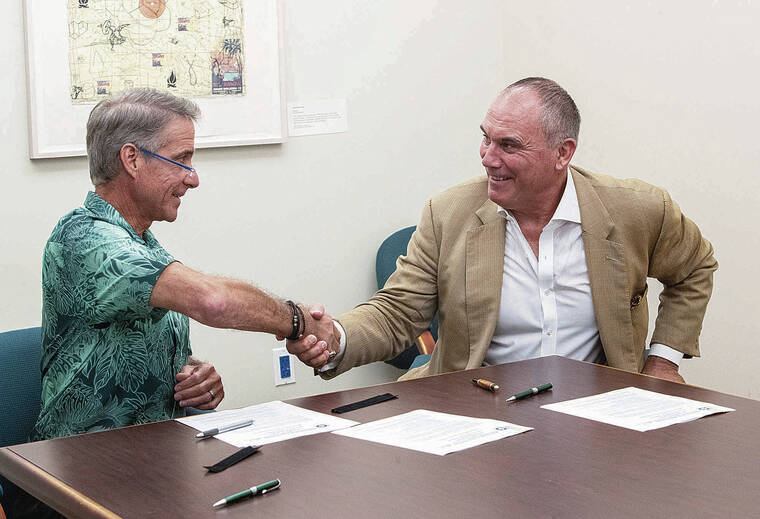UH signs deal to develop new satellite technology

CINDY ELLEN RUSSELL / CRUSSELL@STARADVERTISER.COM
The University of Hawaii at Manoa and the Missile Defense Advocacy Alliance signed an agreement Tuesday to advance satellite-based technology. UH Provost Michael Bruno, left, and Missile Defense Advocacy Alliance founder and Chair Riki Ellison shook hands after signing the deal.
Under a new agreement, the University of Hawaii at Manoa hopes to promote greater research and development of new satellite-based technologies to better study Earth from space.
That memorandum of understanding — signed Tuesday morning at UH President David Lassner’s office — will see the state’s largest public academic institution partner with Virginia-based group Missile Defense Advocacy Alliance to develop onboard sensors for Earth-orbiting satellites.
While MDAA’s formal mission statement is to “make the world safer by advocating for the development of missile defense systems to defend the United States, its armed forces and its allies against missile threats,” it’s not a spy satellite program they’re building, they state.
Instead, MDAA Chair and founder Riki Ellison said the agreement with UH aims to advance the gathering of peaceful, scientific knowledge rather than military intelligence.
“Right now we’ve got a vast Pacific that’s uncharted and unknown,” Ellison told the Honolulu Star-Advertiser.
The future program will involve students at UH’s School of Ocean &Earth Science &Technology as well as the departments of engineering, physics and astronomy. Ellison said using satellites will allow investigating things ranging from terrestrial energy use to mass fish movements, to other ocean-based issues that directly affect Hawaii.
Don't miss out on what's happening!
Stay in touch with breaking news, as it happens, conveniently in your email inbox. It's FREE!
Michael Bruno, UH Manoa’s provost, said “at its heart” the partnership will be a workforce development program to range from undergraduate to graduate students and others.
“The way you go about developing a modern workforce in an area as sophisticated as space, in my view, you have to begin with a base of knowledge and research that can provide that technical expertise to young people,” Bruno said.
The new UH program — expected to have about 25 students involved annually — could start this summer or fall.
The agreement with MDAA was “an outgrowth of a large university initiative in space sciences,” he added.
“Our work with MDAA is going to be primarily about education, in particular the development and delivery of executive education programs aimed at professionals as well as advanced students in the broad industry that we have defined as space sciences,” Bruno said. “These education programs will be designed to connect the leading-edge research at UH Manoa with student instruction.
“Our goal will be to educate professionals and aspiring professionals about the latest understanding of astrophysics and space sensor technologies,” he said. “The program will not be developing military technology.”
Rather, satellite-based sensors could monitor what’s going on in and around the Hawaiian Islands, he said.
“That could be anything from wildfires to the volcano erupting, to long-period things like climate change impacts,” he added.
Under the three-year agreement, Bruno said the MOU “stipulates that specific activities under the agreement, such as executive educational programs, will be developed and implemented under separate agreements or contracts.”
There is no payment included in this agreement.
“Any discussion of costs will wait until we get into the detailed planning of the programs,” Bruno said.
According to Ellison, MDAA — which initiated similar space-based programs at the University of Arizona and University of Southern California that consider national security threats from above — will bring expertise in space technology, government and policy to advance learning here.
“And the other thing is that, being the center of the Pacific, to have our other Pacific nations send their students to (UH) is in the best interests for the security of our world and for keeping the status quo,” Ellison said.
This agreement comes on the heels of related work to advance space technology in Hawaii.
Earlier this month, UH announced it had launched the space tech development center and student-training hub at its Hilo campus.
“The Space Sciences Initiative is expected to attract millions of dollars in funding, expand Hawaii’s technology sector and create more high-paying jobs on Hawaii Island and across the state,” a Jan. 7 news release states.
To launch that program, UH says it received $2 million in state funds to start the initial design of the facility, which is currently estimated to cost about $30 million to $40 million to construct.
“UH students will receive valuable hands-on training at the center producing instruments for space-based missions and ground-based telescopes,” the release states.
“Ground observatories, including those based in Hawaii, spend tens of millions of dollars on a recurring basis to upgrade equipment and build instrumentation.
“That engineering effort typically occurs outside of the state and the planned facility will be designed to bring a larger fraction of that activity to Hawaii,” the release reads. “The additive manufacturing and precision machining capabilities of the center and its personnel will also be able to support the Pearl Harbor Naval Shipyard and the other Department of Defense entities as well as aerospace and private sector partners.”
Meanwhile, Lassner said the MDAA agreement will advance the university’s academic mission.
“We have incredible capacity in this area,” Lassner told the Star-Advertiser, noting the school has fostered astronomy-, geophysics- and space-related programs at UH for some time. “We have the Hawaii Space Flight Lab that’s launching stuff, we have the (Hawaii) Space Grant Consortium — it’s based here but it’s statewide — and we have community college kids building payload, launching it and winning contests.”
He added “collectively, what this represents to me is pulling these assets together … (and) it’s pretty obvious, so we just got to get going.”




